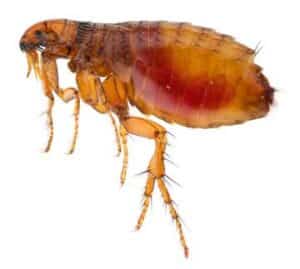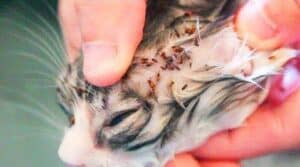If you don’t act fast, fleas can invade and spread through different parts of your home, making eradication difficult. So, you have seen adult fleas, flea dirt, larvae, eggs, and other signs of flea infestation. What should you do next?
Yes, you can invest in commercial pesticides, but does hot water kill fleas and their eggs? If this approach works, it would be convenient since it is readily available. In that case, let’s find out if it does, how fast, and how to use it.
Does Hot Water Kill Fleas And Their Eggs?
Hot water can absolutely kill fleas, and their eggs, so you can adopt it as a strategy against these annoying bugs. However, you cannot just drown them with water at room temperature. Why is that, you ask?
The truth is normal water’s surface tension allows them to float and can even jump out.
Moreover, flea eggs have Plastron, a special structure that can draw out oxygen from the water, thus allowing them to survive.
So, the water needs to be at a certain temperature and expose the fleas and flea eggs for a specific duration for them to die.
Fleas are quite resilient, and their eggs’ protective outer coating makes them resistant to certain environmental conditions. Therefore, ensure the water temperature is above 95°F (35°C) to impact fleas adversely.
Related posts:
- Will just water and dish soap kill fleas on a carpet?
- Can I Rub Lemon Water On My Pets To Get Rid Of Fleas?
- How To Tell How Bad A Flea Infestation Is
However, for the best outcomes, the water should be around 120°F (49°C) and 140°F (60°C).
However, as you already know, hot water is dangerous, so prioritize your safety and that of your pets when handling hot water. For that reason, take precautions to avoid burning yourself or your pet.
Related Post: How to get rid of fleas on cats
Moreover, remember that hot water alone may not be sufficient to address a bad flea infestation comprehensively. So, it’s in your best interests to combine hot water treatment with other measures for more effective results.
But which measures, you ask? They can include vacuuming, washing bedding and fabrics, using flea control products on pets, and implementing environmental treatments to eliminate fleas from your home.
Also Read:
How Fast Do Fleas Die In Hot Water?
The fleas in your home can die relatively quickly in hot water, provided you expose them to temperatures above their tolerance level. Target flea-infested areas of your home to water at temperatures between 120°F (49°C) and 140°F (60°C), and you will likely start seeing dead fleas within a few minutes.
However, water temperature alone isn’t the only determinant for the duration the fleas die from hot water. Take factors like fleas species and their life stage, duration of exposure, and a fleas’ resilience into account. For these reasons, the fleas can die quickly or take longer.
For instance, expect adult fleas to take longer to die from hot water compared to flea eggs, larvae, and pupae because mature fleas are generally more resistant to heat. However, this doesn’t mean flea eggs are helpless against hot water.
Far from it, eggs and pupae have protective coatings that can make them more resistant to environmental conditions, including heat.
Also, give hot water a better chance of killing within the shortest time by keeping the affected area saturated with hot water for at least 5 to 10 minutes.
Related Post: How to get rid of fleas in house
How To Use Hot Water To Kill Fleas
Now that you know that hot water kills fleas, you must know how to use this approach to ensure your flea eradication project is successful. Let the following steps guide you.
1. Identify Target Areas
You cannot just pour hot water anywhere with the hopes of killing fleas because that will be just a waste of your time. So, first, determine the areas where fleas are likely to be present, such as pet bedding, carpets, rugs, or upholstery.
2. Prepare The Water
Boil water aiming for a temperature between 120°F (49°C) and 140°F (60°C), then transfer it to a container or basin. A reliable thermometer will help you get the desired water temperature, ensuring it is within a safe range.
3. Immerse or Apply Hot Water
The application approach will depend on the affected item or surface’s size. For instance,
- Immerse smaller items like pet bedding or washable fabrics in hot water for several minutes. You must agitate the item to ensure the hot water penetrates deeply.
- When dealing with larger items like carpets or upholstery, use a container with a spout or a spray bottle to apply the hot water directly to the targeted areas. Thoroughly wet the surfaces, ensuring the hot water reaches deep into the fibers.
4. Maintain Exposure
The effectiveness of the hot water treatment depends on the exposure time. In that case, keep the items or surfaces saturated with hot water for at least 5 to 10 minutes.
5. Clean And Dry
After giving the hot water treatment ample time to act on the fleas and their eggs, thoroughly clean the treated areas. Also, don’t forget to eliminate any dislodged dead fleas, eggs, or debris. A vacuum cleaner will help you do so. Furthermore, let the items or surfaces dry completely.
5. Continue With Additional Flea Control Measures
You can not rely on hot water treatment alone to get rid of the whole flea population. So, consider introducing other flea control methods in conjunction with the hot water.
Safety Precautions When Killing Fleas With Hot Water
Safety is everything when handling hot water. You wouldn’t want to burn or scald your skin. So, follow these safety guidelines for safely handling hot water in the context of flea control.
a) Use Protective Gear
Put on heat-resistant gloves! They will protect you from burns or scalding while handling hot water.
b) Test The Water Temperature
Use a reliable thermometer to check the water temperature before applying hot water to any surface or area to make sure it is not too hot.
c) Don’t Use Boiling Water
Boiling water can cause severe burns and damage surfaces, so keep the water between 120°F (49°C) and 140°F (60°C). These temperatures are warm enough to eliminate fleas but not sufficient enough to cause scalding.
d) Apply Water Carefully
Pour or apply hot water cautiously to targeted areas for your safety. Control the water flow using a container with a spout or nozzle to minimize the risk of accidental splashing.
e) Protect Yourself And Pets
Do not expose yourself and your pets directly to the hot water. So, keep a safe distance and avoid contact with the hot water to prevent burns or discomfort.
Final Remarks
Due to fleas’ parasitic nature, they can only survive narrow temperature ranges, so cold temperatures (under 40°F and high temperatures (above 120°F). Therefore, hot water can help you kill these pests and ensure your home and pets are free of them.

I’m Mike Hyle, an exterminator with 7+ years of experience handling all sorts of pests, including mice, cockroaches, bed bugs, and termites. I also write for Pest Solutions DIY blog to share my knowledge and help homeowners keep their homes pest-free. Outside work, I enjoy hunting, snowshoeing, and exploring nature. Check out my blog for helpful pest control tips!


